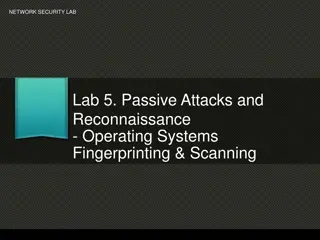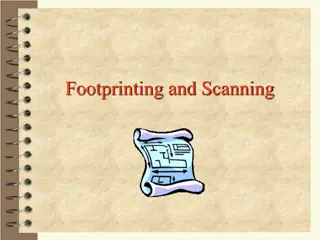
Advanced Hacking Techniques and Intrusion Detection Overview
Dive into the world of hacking techniques and intrusion detection with expert Ali Al-Shemery. Explore topics such as footprinting, external and internal ranges identification, WHOIS lookups, passive reconnaissance, and more. Learn valuable insights to enhance your understanding of cybersecurity. All materials are licensed under a Creative Commons Share Alike license.
Download Presentation

Please find below an Image/Link to download the presentation.
The content on the website is provided AS IS for your information and personal use only. It may not be sold, licensed, or shared on other websites without obtaining consent from the author. If you encounter any issues during the download, it is possible that the publisher has removed the file from their server.
You are allowed to download the files provided on this website for personal or commercial use, subject to the condition that they are used lawfully. All files are the property of their respective owners.
The content on the website is provided AS IS for your information and personal use only. It may not be sold, licensed, or shared on other websites without obtaining consent from the author.
E N D
Presentation Transcript
Hacking Techniques & Intrusion Detection Ali Al-Shemery arabnix [at] gmail
All materials is licensed under a Creative Commons Share Alike license. http://creativecommons.org/licenses/by-sa/3.0/ 2
# whoami Ali Al-Shemery Ph.D., MS.c., and BS.c., Jordan More than 14 years of Technical Background (mainly Linux/Unix and Infosec) Technical Instructor for more than 10 years (Infosec, and Linux Courses) Hold more than 15 well known Technical Certificates Infosec & Linux are my main Interests 3
Footprinting Walking the trails to a target
Outline External Footprinting Identify External Ranges Passive, and Active Internal Footprinting Identify Internal Ranges Passive, and Active 5
Identify Customer External Ranges The major goals of intelligence gathering during a penetration test is to determine hosts which will be in scope. Common techniques to identify: WHOIS searches on the domains and the ranges reverse DNS lookups DNS brute forcing 7
Passive Recon - WHOIS Lookups Determine TLD for the domain, and which WHOIS server contains the information we're after. WHOIS information is based upon a tree hierarchy. ICANN (IANA) is the authoritative registry for all of the TLDs. Middle East WHOIS lookup (registrar): RIPE NCC, http://www.ripe.net/lir-services/member- support/info/list-of-members/mideast DEMO (whois) 8
Passive Recon - NetCraft Internet monitoring company that monitors uptimes and provides server operating system detection. Site Report returns information such as: IP address Name servers Reverse DNS Netblock owner DNS admin Domain registry DEMO 9
Passive Recon - URL(s) Extract list of URLs from a web page list-urls.py Search for files in a domain goofile.py FOCA DEMO 10
Online Tools Central Ops, http://centralops.net/ Wayback Machine: http://archive.org/ Zone-h Defacement Archive, http://zone-h.org/ Domain Tools, http://www.domaintools.com/ DNS Stuff, http://www.dnsstuff.com MX Toolbox, http://mxtoolbox.com RIPE, http://www.ripe.net/data-tools/db WHOIS, http://www.whois.com/whois/ WHOIS, http://www.whois.sc/ What Is My IP, http://www.whatismyip.com/ InterNIC, http://www.internic.net/ 11
Google for Pentesting Check Johnny Long s presentation @Blackhat Google Dorks, http://www.exploit- db.com/google-dorks/ Google Hacking Database (GHDB), http://www.hackersforcharity.org/ghdb Assignment #1: Write about 10 Google Dorks. 12
ShodanHQ ShodanHQ.com is a computer search engine. Examining the response of the devices it contacts on the Internet. Information gathered such as: Target OS, Web server software version Checks if default user/pass are being used Can identify webcam, firewalls, and VoIP devices Can identify network printers Need Help? www.shodanhq.com/browse Registration is required to make the most effective use of the site. 13
Active Footprinting Port Scanning Next Week 14
DNS Discovery Performed by looking at the WHOIS records for the domain's authoritative nameserver. Variations of the main domain name should be checked, and the website should be checked for references to other domains which could be under the target's control. 15
DNS Discovery DNS Types A MX NS CNAME or aliases Host s IP address. Host/domain s mail exchanger(s) Host or domain s name server(s) Host s canonical name allowing additional names SOA SRV Initiation Protocol (SIP) and the Extensible Messaging and Presence Protocol (XMPP) Authority for the domain Service location record often used with Session RP PTR lookups Responsible person Pointer to a canonical name, used for reverse 16
Zone Transfers DNS zone transfer, also known as AXFR, is a type of DNS transaction. It is a mechanism designed to replicate the databases containing the DNS data across a set of DNS servers. Zone transfer comes in two flavors, full (AXFR) and incremental (IXFR). Tools commonly used: host, dig, and nmap DEMO 17
Reverse DNS Reverse DNS can be used to obtain valid server names in use within an organizational. There is a caveat that it must have a PTR (reverse) DNS record for it to resolve a name from a provided IP address. 18
Forward DNS Some call it DNS Bruteforcing Not only zone transfers! Discover additional host names that are not commonly known. fierce.pl dnsenum.pl dnsrecon.py DEMO 19
SMTP SMTP bounce back, also called a Non-Delivery Report/Receipt (NDR), a (failed) Delivery Status Notification (DSN) message, a Non-Delivery Notification (NDN) or simply a bounce, is an automated electronic mail message from a mail system informing the sender of another message about a delivery problem. Done by simply creating a bogus address (Blah_blah_address@target.com) within the target's domain. 20
SMTP Tools SMTP User Enumerator, smtp-user-enum smtp-user-enum.pl -M VRFY -U users.txt -t 10.0.0.1 SMTP Scan, smtpscan SMTP Relay Checker, smtprc Swiss Army Knife for SMTP, swaks Nmap NSE script, smtp-enum-users.nse DEMO (Online Central Ops): Central Ops (Email Dossier), http://centralops.net/co/ Manually 21
Banner Grabbing An enumeration technique used to glean information about computer systems on a network and the services running its open ports. Banner grabbing is used to identify network the version of applications and operating system that the target host are running. Usually performed on: HTTP, FTP, and SMTP Tools commonly used: Telnet, Nmap, and Netcat 22
SNMP Sweeps SNMP offer tons of information about a specific system. The SNMP protocol is a stateless, datagram oriented protocol. Unfortunately SNMP servers don't respond to requests with invalid community strings and the underlying UDP protocol does not reliably report closed UDP ports. This means that "no response" from a probed IP address can mean either of the following: machine unreachable SNMP server not running invalid community string the response datagram has not yet arrived 23
Web Application Discovery Identifying weak web applications can be a particularly fruitful activity during a penetration test. More on this when we reach Web Penetration Testing 24
Virtual Host Detection & Enumeration Web servers often host multiple "virtual" hosts to consolidate functionality on a single server. If multiple servers point to the same DNS address, they may be hosted on the same server. Tools such as Bing search can be used to map an IP address to a set of virtual hosts. 25
Establish External Target List Once the activities above have been completed, a list of users, emails, domains, applications, hosts and services should be compiled. Mapping versions Identifying patch levels Looking for weak web applications Identify lockout threshold Error Based Identify weak ports for attack Outdated Systems Virtualization platforms vs VMs Storage infrastructure 26
Passive Footprinting If the tester has access to the internal network, packet sniffing can provide a great deal of information. Use techniques like those implemented in p0f to identify systems. # p0f o cap.txt -i eth0 -M -V -v -p -t 28
Identify Customer Internal Ranges Start by identifying the local subnet, then modify slightly to reach other subnets. Check routing tables of hosts. Most popular technique used is checking DHCP servers. 29
Active Footprinting We can perform all the external active footprinting techniques here. Port Scanning: Internal port scanning differs from external port scanning, because of the higher bandwidth available, and the ability to get more accurate response. Next Week 30
? Countermeasure Mitigation Remediation 31
Assingment(s) Assignment #2: Gathering information about a website from Google cache, is it an Active or Passive Recon? Assignment #3: Choose a target that you have permission to, maybe yourself and try to gather as much information found publicly as you can. Write a report about that. 32
SUMMARY We saw what is intelligence gathering The OSINT three What corporate info to gather What individual info to gather Understood the covert gathering types What is footprinting Difference between active and passive footprinting Main external and internal footprinting information resources How to use Google when performing intelligence gathering Discusses mitigation to footprinting 33
References Effective meetings, http://www.businessandthegeek.com/?p=112 Penetration Testing Standards, http://www.pentest-standard.org/ FOCA, http://www.informatica64.com/foca/ Foundstone, Johnny Long, Blackhat, Google Hacking for Penetration Testers, Exploit-DB, Google Dorks, NetGlub, Paterva Maltego, WHOIS lookup references ICANN - http://www.icann.org IANA - http://www.iana.com NRO - http://www.nro.net AFRINIC - http://www.afrinic.net APNIC - http://www.apnic.net ARIN - http://ws.arin.net LACNIC - http://www.lacnic.net RIPE - http://www.ripe.net , RIPE NCC SensePost BiLE Suite, http://www.sensepost.com/labs/tools/misc List of DNS Record Types, http://en.wikipedia.org/wiki/List_of_DNS_record_types 34






